Hazarduari Palace
Coordinates: 24°11′11″N 88°16′08″E / 24.186409°N 88.268755°E
| Hazarduari Palace | |
|---|---|
 The grand palace of Hazarduari illuminated at night | |
| Former names | Bara Kothi |
| Alternative names | Nizamat Kila |
| General information | |
| Architectural style | Italian-style palace built in the 19th century and Greek (Doric) style |
| Location | Murshidabad district |
| Town or city | In Murshidabad, near Lalbagh. Lalbagh is a neighbourhood in Murshidabad. |
| Country | India |
| Coordinates | 24°11′11″N 88°16′08″E / 24.186409°N 88.268755°E |
| Groundbreaking | August 9, 1829 |
| Completed | December, 1837 |
| Cost | ₹16.50 Lacs |
| Owner | Archaeological Survey of India and the Government of West Bengal |
| Height | 80 feet |
| Dimensions | |
| Other dimensions | Length: 130 meters and Breadth:61 meters |
| Technical details | |
| Floor count | 3 |
| Design and construction | |
| Architect | Colonel Duncan MacLeod |
| Other information | |
| Parking | available |
| Website | |
| "Website". | |
Hazarduari PalaceBengali: হাজারদুয়ারি, earlier known as the Bara Kothi,[1] is located in the campus of Kila Nizamat in Murshidabad, in the Indian state of West Bengal. It was built in the nineteenth century by architect Duncan Macleod, under the reign of Nawab Nazim Humayun Jah of Bengal, Bihar and Orissa (1824–1838).
The foundation stone of the palace was laid on August 9, 1829, and that very day the construction work was started. William Cavendish was the then Governor-General. Now, Hazarduari Palace is the most conspicuous building in Murshidabad.
In 1985, the palace was handed over to the Archaeological Survey of India for better preservation.[2][3]
Kila Nizamat
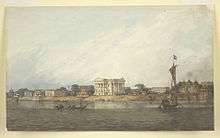
Kila Nizamat or Nizamat Kila (English: Nizamat Fort) was the site of the old fort of Murshidabad.[4] It was located on the present site of the Hazarduari Palace, on the banks of the Bhagirathi River. The fort was demolished to build this grand palace.
Now, Kila Nizamat refers to the campus where the palace is located along with the Nizamat Imambara, Murshidabad Clock Tower, Madina Mosque, Chawk Masjid, Bacchawali Tope, the Shia Complex, Wasif Manzil, the two Zurud Mosques - one on the east of the palace and the other one between the Wasif Manzil and the south gate of the palace - and the Nawab Bahadur's Institution (or, Nizamat College) surrounding it. Tourists call the Hazarduari Palace the Nizamat Kila or the Kila Nizamat.
Construction

The palace was built and designed under the supervision of Colonel Duncan MacLeod of the Bengal Corps of Engineers. He was the father of Sir Donald McLeod. The foundation stone of the palace was laid by Nawab Nazim Humayun Jah of Bengal, Bihar and Orissa (1824–1838) on August 9, 1829, and that very day the construction work was started. The construction was completed in December 1837.
Incident
The concrete bed on which the foundation stone was to be laid was built so deep that the Nawab had to use a ladder to descend. The suffocating atmosphere created due to the large concourse of people, which stood surrounding them, caused His Highness to faint. The foundation stone was laid after he was brought up.
Etymology
The name of the palace that is Hazarduari means "a palace with a thousand doors". Hazar means "thousand" and Duari means "the one with doors"; thus, the total sums up to "the one with a thousand doors".
The palace earlier known as Bara Kothi has been named so as the palace has in all 1000 doors, of which 100 are false. They were built so that if any predator tried to do something wrong and escape, he would be confused between the false and real doors, and by that time he would be caught by the Nawab's guards.[5]
Palace
The enclosure where the palace is situated is known as Kila Nizamat or Nizamat Kila. The campus except this palace, has in addition the Nizamat Imambara, Wasif Manzil, the Bachhawali Tope, Murshidabad Clock Tower, three mosques out of which one is the Madina Mosque, and the Nawab Bahadur's Institution. Other buildings include residential quarters. It is situated on the east bank of the Bhagirathi River, which flows just beside it. The gap between the Bhagirathi's banks and the palace is just 40 feet (12 m); however, the foundations are laid very deep, which protect the palace. The palace is rectangular in plan (130 meters long and 61 meters broad) and is a good example of Indo-European architecture. The front facade of the palace, which has the grand staircase, faces north. This staircase is perhaps the biggest one in India.
The palace has 1000 doors, of which 900 are false, and a total of 114 rooms.
The wooden Nizamat Imambara built by Siraj ud-Daulah caught fire in 1846, so the present building was rebuilt within a year in 1848 by Nawab Nazim Feradun Jah of Bengal, Bihar and Orissa. This Imambara is the biggest one in India. More than ₹6 lacs were spent for its construction.
The Madina Mosque is kept open for a look at the Muharram festival by the general public but is kept closed throughout the year.
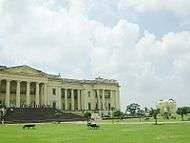
The Bacchawali Tope which lies in the campus of Kila Nizamat was brought by Murshid Quli Khan. This cannon has been placed on high altar and its mouth has been covered up with an iron plate. It is said that when used it made such a huge noise that it forced pregnant women to give birth to babies at that very time.
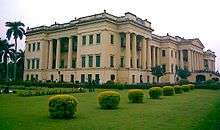
The palace was used to hold durbars (official or royal meetings) and official works between the Nawabs and the Britishers and also used as a residence for high-ranking British officers. It has now been transformed into a museum which houses collection from the Nawabs like priceless paintings, furniture, antiques.

A grand flight of stairs of 37 steps of stone, the lowermost one of which is 108 feet (33 m) long, leads up to the palace's upper portico. Perhaps it is the largest one in India. The pediment of the palace is supported by 7 huge pillars, each being 18 feet (5.5 m) at the base. There is also the Nawabi Coat of Arms depicted on the pediment. This grand staircase is perhaps the biggest one in India.
On either side at the beginning of the grand staircase are two statues of two seated masonry Victorian lions with stone slabs embedded in the wall behind them.
There are several large gates used as an entrance to the palace some which bear names like the Imambara, Chawk and Dakshin Darwaza (south gate). The main gates have Naubat Khanas (musicians' galleries) over them and are large enough that an elephant may pass with a howdah on its back.
Museum
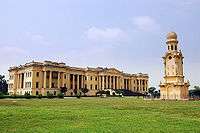
The palace has now been transformed into a museum which houses collections from the Nawabs like priceless paintings, furniture, antiques and so on. The famous one is the mirror and the chandelier. In 1985, the palace was handed over to the Archaeological Survey of India[2][3] for better preservation. The Hazarduari Palace Museum is regarded as the biggest site museum of Archaeological Survey of India and has got 20 displayed galleries containing 4742 antiquities out of which 1034 has been displayed for the public. The antiquities include various weapons, oil paintings of Dutch, French and Italian artists, marble statues, metal objects, porcelain and stucco statues, farmans, rare books, old maps, manuscripts, land revenue records, palanquins mostly belonging to eighteenth and nineteenth centuries, a bamboo from Assam and so on.
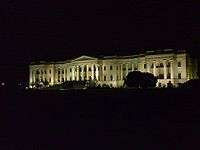
The Durbar Hall of the palace which houses the furniture used by the Nawab has a crystal chandelier hung from the ceiling. It is the second largest chandelier in the world, after one in Buckingham Palace. It was given to the Nawab by Queen Victoria.
There are also two pairs of mirrors in the museum, that are placed at an angle of 90 degrees in such a way that one cannot see one's own face but others can see. It was used by the Nawab to prevent predators from harming him, and was kept at a place so that the predator cannot see his face and think a mirror to be there but the Nawab could and he would be caught.
Museum galleries

In the entrance porch there are two carriages, of which one is a camel carriage and the other is a Victorian carriage. Both of them were used by the Nawabs. The lobby has been decorated with photographs of several buildings of historical importance and it also has a huge stuffed crocodile and a thick bamboo from Assam. There in all 20 galleries as follows:
- Gallery no. 1 and 2 also known as Armoury wing A and B houses the armoury. This gallery is rich in technical skills and is used to display the various weapons like knives, guns, pistols, revolvers, cannons, lances, spears, shields, bows, arrows, rifles and so on. They are inscribed with holy verses from the Holy Quran. Some weapons which need special attention are the Jamadhara and a bifurcated sword known as Zulfikar. Both of them are associated with Mir Qasim. Some of the other most important artifacts are the swords of Alivardi Khan, Siraj ud-Daulah and so on. The dagger by which Muhammad i-Beg killed Siraj ud-Daulah can also be seen here. The magic mirrors (as discussed above) are kept just outside the gallery on the landing area of the staircase which leads to the upper floors. A huge cannon known as the Dutch cannon can be seen here which was given to Alivardi Khan by the Dutch Government in 1745. It is generally known as the Mir Madan Cannon. Mir Madan was a trusted lieutenant of Siraj ud-Daulah who died in the Battle of Plassey in 1757 due to the bursting of this cannon.
- Gallery no. 3 is the gallery of Royal Exhibits. It houses several paintings and objects of silver and gold and several statues each of historical, political and religious importance. The gallery has been divided into three parts such as the Suthest Royal Exhibits which houses and exhibits huge oil paintings of the Nawabs such as the painting of Nawab Nazim Humayun Jah by Hutchinson and that of Nawab nazim Feradun Jah by B. Hudson. One of the most renowned objects is an ivory palanquin used by Zebunissa, the daughter of the Mughal emperor Aurangzeb (1658–1707 AD). The next part is called the Central Royal Exhibits, which displays several objects such as a silver kamal howdah, an ivory Tanjam and son, each of famous kings or Nawabs. The South West Royal Exhibits houses several traditional objects like palanquins, statues; paintings and so on.

- Gallery no. 4 is also known as the Landscape Gallery. It has paintings of several landscapes. It has replicas of the Statue of Liberty, bronze statues of knights, and famous paintings like the Scotch Warrior by G. Campbell, Scene of Thirty Years of War by Jorgenson, and so on.
- Gallery no. 5 is known as the British Portrait Gallery. As the name suggests it has busts of the Governor-General of India and agents of the East India Company like Lord Cornwallis, Lord William Bentinck, A. Thompson and so on, all of them by Hudson except that of Mr. Caulifield by Hutchinson. Several arrays of vases displayed, giving a taste of rich European ceramic. They can be found in several colours and varieties and are a thing to adore.

- Gallery no. 6 is known as the Nawab Nazim Gallery. As the name suggests it exhibits portraits portraying the Nawabs of Murshidabad. It also has several brass objects.
- Gallery no. 7 is the Durbar Hall. It is the center attraction of the palace cum museum. It is circular in plan and has four doors at the cardinal points, some of which-as mentioned above-are fake. The Durbar also has a vaulted roof with the crystal chandelier (as discussed above, is perhaps the second largest in the world after the one at the Buckingham Palace) hung from the ceiling. It was presented to the Nawab by Queen Victoria. Earlier when there was no electricity the chandelier was lit by 1001 candles; at present it is lit by 96 bulbs. In addition, one can see the royal silver throne which was used by the Nawabs to sit, a Durbari Hookah, marble candle stands, all of them witnesses of the British Colonial Rule.
- Gallery no. 8 is the Committee Room, on the left side of the Durbar hall. It exhibits the silver throne of Feradun Jah, an ivory sofa, and an oil painting of the Durbar Hall with Feradun Jah on the throne surrounded by Britishers of high status.

- Gallery no. 9 is known as the Billiards Room. It displays two billiards tables with their accessories, a pietra dura marble chess set, and four remarkable paintings like that of Colonel Duncan McLeod by Hudson. McLeod was the architect of this grand palace.
- Gallery no. 10 is the portrait gallery of the Dewans and Nazirs. This gallery displays portraits of the Dewans of the Nawabs. Dewans were the ministers of the Nawabs and also the revenue collectors. The gallery also exhibits several vases, chandeliers and furniture.
- Gallery no. 11 is known as the Prince Portrait Gallery. This gallery displays paintings from the Nawabs' family album portraying the infancy and various other moods of the Nawabs. There are also several marble statues, cut-glass melons, vases, metal horses, porcelain bear and so on.
- Gallery no. 12 is known as the Western Drawing Room. It exhibits several items of western furniture, decorative lamps, clock items and so on. It also has some paintings like that of King William IV, Lord Curzon and so on, all by Wolic.
- Gallery no. 13 is known as the Archive Gallery. It has several archives of the Nawabs' rule and also on the palace. It also has several letters, farmans (royal orders), documents, manuscripts in Arabian and Persian and so on, as Persian was the official language of the Nawabs and the Mughals. These documents also speak abou the administrative power of the Nawabs. Letters like those written by Lord Minto, written to Lord Hastings and a royal order by Mughal emperor Shah Alam II can be seen here. It also has several valuable and old manuscripts written in Urdu and Persian, the most prized possession being the Ain-i-Akbari written by Abul Fazal. At the end of each page of the manuscript, ornamental works with the smallest brush and pen are visible on the corners of the pages. It also has a library known as the Nizamat Library which has books, the books kept number around 12,000. Most of them are written in English, Urdu and Persian.
- Gallery no. 14 and 15 is known as the Periodical Gallery I and II. These two galleries are used to periodically display several objects used and brought or made during reign of several Nawabs. These include Humayun Jah's collectio of rare dining plates, there are also some green plate which were shattered if poisoned food was served; others include several landscape oil paintings, an ornamental silver dressing table, floral and geometric motifs and so on.
- Gallery no. 16 is known as the Central Landing or the Main Hall. It exhibits several oil paintings. One artifact which deserves special attention is a silver trowel with an ivory handle used by Humayun Jah to lay the foundation stone of the building.
- Gallery no. 17 is called the North-east Landing First Floor. It exhibits several paintings. A beautiful statue of a European lady is the most renowned here in this gallery.
- Gallery no. 18 is known as the North-west Landing First Floor. As gallery number 17 it also exhibits several paintings like the Swiss Landscape, City of Venice and so on.

- Gallery no. 19 is called the Painting Gallery. As the name suggests it exhibits several paintings like the Holy Family by Franceso Renaldi, Cleopatra Cinderella by T. Younlery. It exhibits several objects used for religious purposes, like in Muharram and Eid, a religious banner with Arabic inscriptions from the Holy Quran and so on. Others include a Chob (lion mask), zaman-alams from the period of Feradun Jah and Humayun Jah, silver inscribed panjas and so on.
Miniature
A miniature of the palace,[6] made by Sagore Mistri in ivory, along with portraits of His Highness and his son, among other presents, were sent to King William IV. He honoured the Nawab with a full-size portrait of His Majesty and an autographed letter, and conferred upon him the badge and insignia of the Royal Guelphic and Hanoverian order, which are still preserved in the Palace.
Map
See also
References
- ↑ "History of Murshidabad". Retrieved March 28, 2012.
- 1 2 Palace handed ovet to ASI
- 1 2 Handed over to ASI
- ↑ "Nizamat Kila". Retrieved March 30, 2012.
- ↑ "Hazarduari Palace". Retrieved March 28, 2012.
- ↑ Palace's miniature Archived January 6, 2012, at the Wayback Machine.
External links
 Hazarduari Palace travel guide from Wikivoyage
Hazarduari Palace travel guide from Wikivoyage- "Wonders of India: Hazarduari Palace" on YouTube
| Wikimedia Commons has media related to Hazarduari Palace. |
